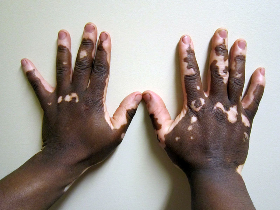5 Facts About Vitiligo That You May Not Have Known!
On Jun 20, 2013
-
 Vitiligo on the hands of a dark skinned person.Image source: Wikipedia by author James Heilman, MD
Vitiligo on the hands of a dark skinned person.Image source: Wikipedia by author James Heilman, MDKeypoint Tweet @CentralSkin: 5 fast facts about vitiligo that may help you better understand this potentially disfiguring disease.
Reader Requested Feature Article: This article was written at the request of one of our readers. Please feel free to submit any topic which you would like us to write about in the future!
1. Vitiligo is caused by the auto-immune destruction of your melanocytes.
Vitiligo is a condition in which you develop white patches of skin over various parts of your body. It is a result of the loss of melanin, the pigmenting component in the upper layer of your skin. In the course of vitiligo, the melanin producing cells in your skin, the melanocytes, are destroyed, melanin production ceases and your skin may become depigmented. Vitiligo is caused by an autoimmune reaction, or an attack on your melanocytes by your body’s own immune system. Thus far, there is no clear evidence of what initiates this autoimmune reaction. However, vitiligo is associated with other autoimmune conditions such as Addison’s disease, hypo- and hyperthyroidism, and pernicious anemia.
2. Premature graying on your scalp or eyebrows may be a sign of vitiligo.
Vitiligo usually first affects the sun-exposed areas of your skin such as your hands, feet, arms, legs, and lips. Less common signs of vitiligo include the loss of color on the inside of your mouth and premature graying or whitening of the hair on your scalp, eyebrows, or beard. However, before your mind races to vitiligo at the first sign of gray, you must realize that many other conditions and the natural aging can mimic this sign.
3. Vitiligo does NOT affect dark skinned people more than light skinned people.
In fact, vitiligo affects 1% to 2% of the population, irrespective of age, sex, or race. The reason for the misconception that vitiligo is more common in dark skinned individuals is that vitiligo stands out more in dark skinned people because of the contrast between the depigmented areas of skin and their dark skin tone.
4. Not all white spots on your body are vitiligo!
While vitiligo is one of the reasons for depigmentation, or white spots, developing on your body, it is not the only reason. Thus before worrying, make an appointment with a dermatologist who can assess and correctly diagnose your condition. Other causes of white spots on your skin include tinea versicolor (a type of fungus), pityriasis alba (a self-limited scaly skin condition usually seen in children), chemical leukoderma (result of exposure to certain depigmenting chemicals), post-inflammatory hypomelanosis (your body’s reaction to inflammation from diseases such as psoriasis or eczema). A diagnosis of vitiligo is usually made on clinical exam alone. However, a skin biopsy may be necessary to exclude some of the other potential causes of white spots.
5. There are four categories of treatment options for vitiligo.
The treatment options for vitiligo are sunscreens, cover-up, restoration of normal skin color with medication/light treatments, and in severe cases, bleaching of the normal skin to remove remaining pigment to give an even color to the skin. Please read our follow-up article, "What Are The Treatments For Vitiligo?" for an in-depth review of the various treatment options.


Comments
Leave a Comment